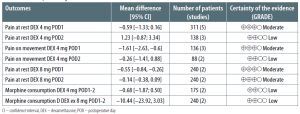ANAESTHESIOLOGY - REGIONAL ANAESTHESIA / REVIEW ARTICLE
Perineural dexamethasone added to peripheral nerve block in knee surgery: a systematic review with meta-analysis
1
Department of Surgery, School of Medicine, Nazarbayev University, Astana, Kazakhstan
2
Department of Anesthesiology, Intensive Care and Pain Medicine, National Research Oncology Center, Astana, Kazakhstan
3
Department of Mechanical and Aerospace Engineering, School of Engineering and Digital Sciences, Nazarbayev University, Astana, Kazakhstan
Submission date: 2023-11-30
Final revision date: 2024-12-02
Acceptance date: 2024-12-02
Publication date: 2025-02-19
Anaesthesiol Intensive Ther 2025;(1):31-41
KEYWORDS
dexamethasoneperineuralknee surgerymorphine consumptionpain intensityperipheral nerve blockadjuvantcorticosteroids
TOPICS
ABSTRACT
The objective of the study was to assess the analgesic effects of dexamethasone (DEX) added to peripheral nerve block in knee surgery. We searched for relevant randomized controlled trials (RCTs) in PubMed and the Cochrane Database of Systematic Reviews. The latest search was done on September 11, 2024. Search terms included knee surgery, regional anesthesia, and DEX. Data extraction, statistical analysis, and risk of bias assessment followed established protocols. Seven RCTs with 551 patients were included. In the DEX 4 mg group, no reduction of pain at rest was found. However, for the DEX 8 mg group, pain management at rest was more effective; the mean difference (MD) with 95% CI was –0.34 [–0.50, –0.18]. For pain with movement, the model favors the DEX 4 mg group (MD with 95% CI was –1.03 [–1.84, –0.22]). Only one study reported the differences in pain intensity scores with movement between the DEX 8 mg and control groups. For morphine consumption, the model did not reveal any reduction in the DEX 4 mg group (MD –0.68 [–1.87, 0.5]) or DEX 8 mg group (MD –10.44 [–23.92, 3.03]). Pain with movement may be reduced with a lower dose, and pain without movement with a higher dose of DEX.
We process personal data collected when visiting the website. The function of obtaining information about users and their behavior is carried out by voluntarily entered information in forms and saving cookies in end devices. Data, including cookies, are used to provide services, improve the user experience and to analyze the traffic in accordance with the Privacy policy. Data are also collected and processed by Google Analytics tool (more).
You can change cookies settings in your browser. Restricted use of cookies in the browser configuration may affect some functionalities of the website.
You can change cookies settings in your browser. Restricted use of cookies in the browser configuration may affect some functionalities of the website.



